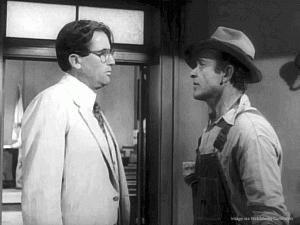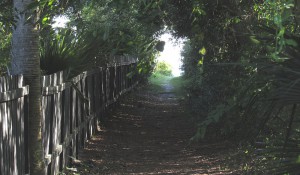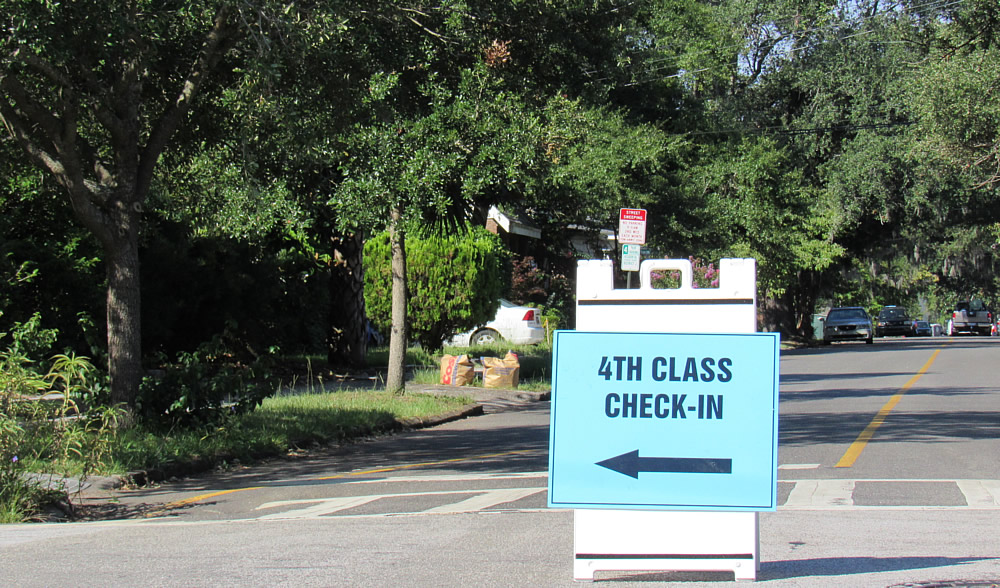Left face
Not only are fourth classmen (freshmen) at The Citadel starting school this week, but thousands of Charleston County primary and secondary students are in local classrooms today, the first day of school for many. Below, publisher Andy Brack offers tips for newbies who will have phones or email for the first time at school.
IN THIS ISSUE
PHOTO: This way, fourth classmen
FOCUS, Kendra Hamilton: Blacks not only victims of racial discrimination
BRACK: Advice for kids with new cell phones, email
IN THE SPOTLIGHT: Morris Financial Concepts, Inc.
MONTHLY, real estate: Market still hot
GOOD NEWS: SCRA reaches big benchmark, more
FEEDBACK: Two letters on forgiveness column
CALENDAR: Aug. 17+: Plays, dancing, fall benefits ahead
REVIEW: Carsick, by John Waters
MYSTERY: A capital idea
S.C. ENCYCLOPEDIA: Prisons and penitentiaries
EDITOR’S NOTE
We’re taking off next week to prepare for a special Aug. 31 edition. We hope you’ll miss us, but we’re sure you’ll get an extra jolt in two weeks.
TODAY’S FOCUSBlacks haven’t been only victims of racial discrimination
By Kendra Hamilton | I enjoyed the Statehouse Report’s discussion of “the elephant in the room” on July 31. But I think a missing element is South Carolina’s legacy of violence against and coercion of … other whites. Two “integration stories” told by friends my age come to mind — stories that helped to shape my thinking, as an African American with deep South Carolina roots, on the dimensions of the problem facing us.
The first, I heard 20 years ago. A bosom friend from Gonzales, La., confided the terror and confusion that descended upon her childhood when she learned that her best friend’s father, a known Klan leader, was believed “by everyone” to have murdered another classmate’s father, a Jew who was active in civil rights. This was in the year that the names Goodman, Schwerner and Cheney screamed from the headlines — but she recalls everyone she knew speaking, if at all, in whispers.
The second I heard last year, while planning the Nat Fuller Feast in Clinton. A Baptist minister on the organizing team — the son of a Baptist minister from rural Georgia — shared the story of waking up one morning and walking out of the door to catch the bus to school … only to see that his house had been vandalized: covered with signs, front and back yards, reading “nigger lover.” He was a popular kid, a football player. His brother was the quarterback. But their father had been preaching against segregation and this public humiliation was the family’s lot.
Who did these people grow up to be? Well, the Baptist minister from Georgia refused to be intimidated, and his son also became a Baptist minister and warrior for civil rights who preaches racial justice here in the heart of a county that practiced lynch law as late as 1937. My girlfriend, meanwhile, found her voice and became a writer, but she remains traumatized, isolated and scapegoated by her family for being “different” and “liberal.”
Why do I repeat these stories? Because I believe whites, in the words of that old song, are not only “carefully taught” to hate, but they are also carefully conditioned to know the consequences if they don’t. The older that one is, the deeper this conditioning runs, and it’s based in part on a well-founded fear of physical harm.
We’re starting to speak openly of the mobs that formed in the 1870s though the 1930s. We’re starting to tell the stories of the African American victims. These are new things, things I didn’t know I’d see in my lifetime. But what we must also acknowledge is that those mobs, their rage and violence, were not just aimed at blacks — the victims included whites as well. Folks who joined the Republican Party, who claimed black kin, or who failed to hide their liking or their loves across the color line, people who were careless, who just didn’t care — these were driven out of the state or defamed, ostracized — disappeared — to create the illusion of a “solid South.”
This, too, is part of the “hidden history” of the South.

Characters Atticus Finch and Bob Ewell have words in the movie adaptation of “To Kill a Mockingbird.”
As an African American of many generations derivation in South Carolina, there are stories in my family of enslavement and Emancipation, of surviving election riots in the 1870s and ‘90s, of finding the occasional ally, but mostly of out-waiting, outwitting or just enduring the ever-present, ever-implacable hostility of whites. These stories functioned the way the spirituals did, as a psychological armor, helping us to survive and even to thrive with our spirits and souls intact.
But it occurs to me that the taboos surrounding discussions of racial matters in the South — the deeply engrained habits of omission and silence — have left whites not just lacking in command of historical facts or an appropriate vocabulary, they have also left people who profess to be non- or anti-racist without an armor to protect them against a common foe: actual racists.
The “elephant in the room” asks what does the state need to do to move forward. Whites must acknowledge that violence and coercion have been exercised against them, too: an external means of control applied until obedience to the “white code” became internalized, automatic.
This is a form of racial trauma, dealt at the hands of their own people, people, who in many cases, claimed to be acting in the name of love. Whites will be called upon to acknowledge these experiences and to connect them to the discussion that began with #blacklivesmatter, that intensified with the Emanuel Nine, and that encompasses even the outcry over the Atticus Finch of [Harper Lee’s] Go Set a Watchman.
Dr. Kendra Hamilton, daughter of former Charleston County Councilman Lonnie Hamilton III, is a poet and assistant professor of English at Presbyterian College where she is director of the Southern Studies Program.
COMMENTARYAdvice for kids with new cell phones, email
EDITOR’S NOTE: With school kicking off for many today across Charleston County, there are lots of kids with new mobile phones and email addresses. So we thought an introduction to these new communications media would be helpful for them — and maybe for you too.
AUG. 17, 2015 | Congratulations. Having a new phone or email address is an obvious sign that you’re growing up. But having new devices or communications media also mean there are some things you need to understand so you don’t get in trouble at school or home.
 About cell phones
About cell phones
Please don’t become one of those glum kids constantly glued to the phone and who rarely looks at the world outside of the screen. Open your eyes. Look around. You’re at a stage in your life that you need to interact and learn directly with people by talking and listening to them in person, not just through a phone.
At school: More than likely, you will be limited in how much you can use the phone. In general, you may be allowed to download apps that will help you with schoolwork. You should keep it off during school and only have it on when teachers say you can.
On the bus or in the car to and from school: One of the reasons you probably got a phone in the first place was to be able to call a parent in case you’re late or the bus has broken down. While you’re riding, please do not spend all of your time texting or playing games. Not only will it eat up a lot of time, but it could get expensive. On the bus home, you should read, do schoolwork so you don’t have so much homework at home, or talk with friends.
At home: You probably should put your phone in a special place where it will always be kept along with the charger and other phone stuff you might need. That way, you won’t lose any of it. In our home, for example, we would ask you to not use the phone until after homework and piano practice. And then, you would only be able to use it after supper to check messages or return any calls. The phone is not allowed in the bedroom and not to be used after 8 p.m.
 Apps: If you are under 15 and you want to download any apps on the phone other than those allowed by the school, you should let a parent know what you are downloading. Some apps will be off-limits to keep you safe.
Apps: If you are under 15 and you want to download any apps on the phone other than those allowed by the school, you should let a parent know what you are downloading. Some apps will be off-limits to keep you safe.
Chat rooms: You should not join any chat rooms. There are bad people out there who might try to convince you to do something you shouldn’t. Resist the temptation.
Personal information: You should not to give out any personal information about yourself to anyone you connect with on the phone or via text or via email. This is a safety precaution. Anyone who is smart about using a cell phone does this to keep private information safe.
About email
Email isn’t as instantaneous as texting or phoning, but there are some common-sense considerations using this tool too.
Do not respond to anyone you do not know. You will get emails from people you do not know (this is called “spam’) who will try to sell you things and get you to sign up for things. Do not do this. Otherwise, you could compromise your security.
Do not download anything at all, at least until you know more about using email and computers. If you click on an attachment, you easily could download a dangerous virus that could destroy the computer. If there is something you want to download, you should check with a parent until you better understand what is good to download and what is bad to download.
Never, ever provide anyone who asks with your address, birth date, phone number or any identification number. If you do so, you are compromising your security and safety. (You don’t want some weirdo showing up at your house, do you?) If you have a question about this, ask your mom or me.
Do not send attachments yet to anyone without permission from a parent and until you better understand how to use email.
Keep your password private. Do not change your password or give it to anyone. When you are signing onto a computer to check your email, make sure no one is looking over your shoulder.
Andy Brack is editor and publisher of Charleston Currents and Statehouse Report. You can reach him at: editor@charlestoncurrents.com
IN THE SPOTLIGHTMorris Financial Concepts, Inc.
 The public spiritedness of our sponsors allows us to bring Charleston Currents to you at no cost to readers. Morris Financial Concepts, Inc., is a nationally recognized, fee-only financial consulting firm that helps you identify and align your resources, values and goals to achieve an enriched life. We do not accept commissions or compensation related to the products and service we recommend. Our counsel is based solely on what we believe is best for each client.
The public spiritedness of our sponsors allows us to bring Charleston Currents to you at no cost to readers. Morris Financial Concepts, Inc., is a nationally recognized, fee-only financial consulting firm that helps you identify and align your resources, values and goals to achieve an enriched life. We do not accept commissions or compensation related to the products and service we recommend. Our counsel is based solely on what we believe is best for each client.
- Learn about founder and Charleston Currents columnist Kyra Morris and more about the consultancy at: Morris Financial Concepts, Inc.
Charleston real estate market still hot
By Doug Holmes, contributing editor
AUG. 17, 2015 | The Charleston real estate market continues to perform very well. In fact, real estate across the nation has made a big recovery. While the smaller, isolated markets may have not recovered much, most larger metropolitan areas have regained much of the ground lost during the 2008-2011 period. I read an article a few days ago that listed the 20 busiest real estate markets in the nation and was a bit surprised to see that Charleston was not listed. This actually brightened my day a bit to know that there were so many markets doing so well.
 Here in Charleston, we are having our third busiest year ever. Through July, we sold more than 9,100 residential units and are well on our way to selling more than 14,000 for the year. Buying activity is up 18 percent over the same period last year. And median sales price is now at an all-time high of $233,000. That is up about 5 percent over the same period last year.
Here in Charleston, we are having our third busiest year ever. Through July, we sold more than 9,100 residential units and are well on our way to selling more than 14,000 for the year. Buying activity is up 18 percent over the same period last year. And median sales price is now at an all-time high of $233,000. That is up about 5 percent over the same period last year.
While many agents and others express concern about this market maybe being too good and possibly getting out of control like it did in 2006, I see many signs in my analysis that point to this recovery being very sustainable. While median sales price is at an all-time high, we are still below the trend line created from sales prices back to 1991. We should have a median sales price of around $250,000 at this point. So, we’re actually undervalued.
More telling to me are the prices per square foot. Most specific areas of Charleston are still down between 5 percent to 10 percent on what their dollar-per-square-foot prices were back in 2006. Just one example is James Island. Back in 2006, the median sales price was $173/sqft on James Island. This year, it is $163/sqft. That’s a 5.8 percent drop over a nine-year period. It was much worse if you compared 2006 numbers to the dismal numbers in 2010 or 2011. We have recovered a lot of the losses, but not entirely. And that pattern is prevalent throughout most of the areas around Charleston, with Mount Pleasant south being a lone exception.
I think this is good news that our prices are rising at a moderate pace rather than skyrocketing out of control. Next month, I’ll try to discuss what’s selling in our market. During the downturn, short sales and foreclosures were the hot topic. Those still exist in our market, but at a fairly insignificant percentage. But there is a new competitor out there for the traditional seller that I’ll discuss next month.
Doug Holmes is a local Realtor with Keller Williams. He also provides markets analysis for a fee to several hundred local real estate agents. He has a bachelor’s degree in physics and math from the College of Charleston as well as a master’s degree in math from the college, where he still teaches a couple of statistics classes in the fall. Visit his website here.
GOOD NEWSSCRA deploys $100 million since 2006 to support state’s knowledge economy
SCRA has made more than $100 million available in funding and infrastructure to help develop the state’s knowledge economy since 2006, according to an Aug. 10 press release touting the accomplishment.
 “We are delighted to have reached this significant milestone as we continue to be the lead catalyst for developing our state’s technology-based economy,” said SCRA CEO Bill Mahoney. “SCRA offers unique opportunities for innovation in South Carolina through research commercialization, high-tech start-up support, available lab and office space and direct investments in technology-based companies. We are pleased that these investments are making a substantial impact throughout the state”.
“We are delighted to have reached this significant milestone as we continue to be the lead catalyst for developing our state’s technology-based economy,” said SCRA CEO Bill Mahoney. “SCRA offers unique opportunities for innovation in South Carolina through research commercialization, high-tech start-up support, available lab and office space and direct investments in technology-based companies. We are pleased that these investments are making a substantial impact throughout the state”.
Nearly $49 million of the investments are from SCRA applied research and development (R&D) and R&D Facilities Sectors, with other approximately $51 million from SCRA Technology Ventures’ Emerging Technologies, SC Launch and Stage 2 Programs.
SCRA is a self-sustaining non-profit applied R&D company that grows the technology-based economy in South Carolina by commercializing intellectual property and supporting and making investments in early-stage companies. Multiple economic impact studies show our cumulative output into South Carolina’s economy to be over $18.1 billion since 1983, creating approximately 15,000 technology-related jobs with annual wages averaging between $55,000 and $79,000.
In other good news:
North Charleston art exhibition: Works by local abstract artist Matthew Dietz and portrait artist Melody Croft of Athens, Ga., will be on display at the North Charleston City Gallery, 5001 Coliseum Drive, from Sept. 3 to Sept. 26.
The concurrent exhibition, offered by the City of North Charleston’s Cultural Arts Department, includes a free public reception with the artists at the gallery from 5 p.m. to 7 p.m.
Dietz will present Process, Pattern, and Transition, a collection of abstract paintings in acrylic created through techniques deeply rooted in his studio practice that convey visual experiences, as well as completely non-objective ideas. “My collections of shapes and space will continue to change as I pursue the next hidden gem. It is the discovery of that gem that completes the art work and keeps me interested in making images,” Dietz said.
In The Space Between Us, Croft will display 12 thought-provoking portraits in oil on canvas with paper that examine the status quo and social norms of modern life. Her “untraditional, realistic narratives” invite viewers to observe and consider the psychological, sociological, or emotional complexities of races, gender, age, and culture. Many of her pieces are inspired by people’s appearance or personality. Croft incorporates letters from newspapers or magazines to include poetry excerpts on her work in order to stir up emotions.
Crowdfunding bookmobile campaign. New pop-up book shop Itinerant Literate launched a crowdfunding:campaign on Aug. 8 to raise $65,000 to raise money to create a full-service mobile bookstore.
 “The majority of the funding is needed for the books themselves, which is something we’re proud of: keeping most of the overhead for the books,” said founder Julia Turner. She and a partner say raising money for Itinerate Literate will allow them to carry a broader spectrum of titles to reflect the varied interest of the community. “Over the past few months, we’ve discovered customers who are excited about the idea and value the adaptability of mobile retail.”
“The majority of the funding is needed for the books themselves, which is something we’re proud of: keeping most of the overhead for the books,” said founder Julia Turner. She and a partner say raising money for Itinerate Literate will allow them to carry a broader spectrum of titles to reflect the varied interest of the community. “Over the past few months, we’ve discovered customers who are excited about the idea and value the adaptability of mobile retail.”
Itinerant Literate’s Indiegogo campaign ends on October 7. After that, they will start looking for a used Airstream trailer, which they hope to turn into a mobile Itinerate Literate bookshop by the end of the year.
- Learn more and find the fundraising campaign: http://www.itinerantliteratebooks.com/
Two thanks on column about forgiveness
To the editor:
![]() WOW! Thank you so much for being the voice for many of us in the community and the faith-based world that believe and feel the same way. Your article [Brack, “Acts of forgiveness may be key to real power“] was so powerful and moving. I can’t imagine the pain of the nine families nor being raised an African American where those horrific events were tolerated, yet even a thought to the human mind.
WOW! Thank you so much for being the voice for many of us in the community and the faith-based world that believe and feel the same way. Your article [Brack, “Acts of forgiveness may be key to real power“] was so powerful and moving. I can’t imagine the pain of the nine families nor being raised an African American where those horrific events were tolerated, yet even a thought to the human mind.
I’m very passionate and burdened when I hear of wrongdoing to a person/people/children/animals that can’t defend themselves or don’t have a voice. Thank you for being a voice in this world today for anyone that lives with the wrong mindset or, most importantly, to anyone who feels they still don’t have a voice.
— Krissie Sanson, Charleston, S.C.
To the editor:
Thank you for your editorial on acts of forgiveness, which I read through Vally’s post on Facebook.
Your thoughts and the quote from Vally Sharpe’s book will touch the hearts of many. The escalating pain and violence in the world has triggered a sharp increase in people’s determination to find a better way. Your and Vally’s observations are helping to light the way.
— Honey Rubin, Campe Verde, Ariz.
Send a letter and tell us what you really think. If you have an opinion on something we’ve offered or on a subject related to the Lowcountry, please send your letters of 150 words or less to: editor@charlestoncurrents.com. Our feedback policy.
CALENDARAug. 17+: Plays, dancing and getting ready for fall benefits
 Dirty Rotten Scoundrels: Through Aug. 23, Footlight Players, 20 Queen St., Charleston. The Footlight Players opens its 84th season with the regional premiere of “Dirty Rotten Scoundrels,” a musical based on the 1988 film of the same name. Performances are 8 p.m. Aug. 7, 8, 14, 15, 20, 21, 22 and at 3 p.m. Aug. 9, 16, 23. Performance is not suitable for children under 13 years. Tickets are $35 for adults; $32 for seniors/military; $25 for students. Order tickets online at footlightplayers.net or by calling the box office at 843-722-4487.
Dirty Rotten Scoundrels: Through Aug. 23, Footlight Players, 20 Queen St., Charleston. The Footlight Players opens its 84th season with the regional premiere of “Dirty Rotten Scoundrels,” a musical based on the 1988 film of the same name. Performances are 8 p.m. Aug. 7, 8, 14, 15, 20, 21, 22 and at 3 p.m. Aug. 9, 16, 23. Performance is not suitable for children under 13 years. Tickets are $35 for adults; $32 for seniors/military; $25 for students. Order tickets online at footlightplayers.net or by calling the box office at 843-722-4487.
Disaster preparedness training for business: 6 p.m., Aug. 19, Room A214, Lonnie Hamilton III Public Services Building, 4045 Bridge View Drive, North Charleston. Charleston County will offer a free seminar for small business owners on disaster preparedness. Register here.
Shaking a leg. The Folly Beach Pier is set to have two more Moonlight Mixers throughout the summer starting at 7 p.m. A DJ will spin great old tunes to keep your feet moving. Dates are Aug. 21 and Sept. 18. In Mount Pleasant, the season’s last dance in the Shaggin’ on the Cooper series will be Sept. 12. Click here for more.
Schein to talk: 7 p.m. Aug. 25, Charleston Jewish Community Center. As part of JCC Jewish Bookfest this year, Beaufort author Bernie Schein will talk about his zany Southern epic novel, “Famous All Over Town,” that revisits South Carolina issues and adds some Charleston gossip. Admission: $5 for JCC members; $7 for all. More: Contact Sandra Brett.
(NEW) Jamaica Day in the Carolinas: Noon to 7:30 p.m., Magnolia Plantation and Gardens. The attraction will host the second annual S.C. Reggae jerk and Wine Festival, featuring international reggae and soca artist Kenne Blessin, and the Dubplates. Tickets are $25 and available at screggaejerkwinefestival.eventbrite.com.
(NEW) Charleston Green Fair: Noon to 5 p.m., Sept. 20, James Island County Park. The 8th annual fair will offer lots of ways to learn about sustainability in day-to-day life. It will feature games, exhibits, contests, fitness opportunities, musical entertainment and much more. Admission is free with $1 gate admission. More: http://www.CharlestonCountyParks.com.
(NEW) Chase After a Cure golf tournament: Sept. 25, Patriots Point Links, Mount Pleasant. The fourth annual Drive Away Childhood Cancer Golf Tournament will benefit Chase After a Cure, a Summerville nonprofit that funds childhood cancer research and raises awareness. Since 2009, the group has raised almost $1 million for research and equipment at MUSC. $400 a foursome. More info: http://www.chaseafteracure.com.
(NEW) Oktoberfest 5K Run-Walk: 9 a.m., Sept. 26, Laurel Hill County Park, Mount Pleasant. The East Cooper Breakfast Rotary Club will host this annual benefit trail run that features a German band, brats and a Bavarian beer garden to welcome participants to the finish line. Costumes encouraged. Learn more and register here: http://oktoberfest5k.net/.
(NEW) Zombie Pub Crawl: 6 p.m. to 11 p.m., Oct. 17, Park Circle, North Charleston. Holy City Brewing will present the fifth annual Pint of Home Zombie Pub Crawl to benefit Lowcountry AIDS Services. Attendees are encourage to dress in their most imaginative zombie gear and visit Park Circle restaurants and bars to check off scorecards for a grand prize. Tickets are $15 in advance; $20 at the door. More: HolyCityBrewing.com.
Bird walks: 8:30 a.m. to noon, every Wednesday and Saturday. This is the time of year that a great variety of migrating birds fly through the Lowcountry so what better time to take part in one of the regular early morning bird walks at Caw Caw Interpretive Center in Ravenel. Pre-registration is suggested. Cost is $5. Walks also are conducted on James Island and Folly Beach. Learn more online.
If you have an event to list on our calendar, please send it to editor@charlestoncurrents.com for consideration. The calendar is updated weekly on Mondays.
REVIEWCarsick
A film by John Waters
 John Waters is commonly known as the Prince of Puke, the Pope of Trash, or just a plain weirdo. In Carsick, Waters chronicles his real-life hitchhiking journey from Baltimore to San Francisco. But that’s just part three. In part one, he imagines his ideal hitchhiking trip. It is full action, including a car chase, a gracious donation to finance future films, and the daring rescue of a kidnapped person stuffed in a trunk. Part two is the worst case scenario. It includes a suicidal drunk driver and a van full of mangy dogs. People not paying attention will forget whether they are reading the best possible trip, worst possible trip, or the real thing. From a dirty demolition derby driver to a Corvette-driving Republican, it’s hard to tell who is real and who is not.
John Waters is commonly known as the Prince of Puke, the Pope of Trash, or just a plain weirdo. In Carsick, Waters chronicles his real-life hitchhiking journey from Baltimore to San Francisco. But that’s just part three. In part one, he imagines his ideal hitchhiking trip. It is full action, including a car chase, a gracious donation to finance future films, and the daring rescue of a kidnapped person stuffed in a trunk. Part two is the worst case scenario. It includes a suicidal drunk driver and a van full of mangy dogs. People not paying attention will forget whether they are reading the best possible trip, worst possible trip, or the real thing. From a dirty demolition derby driver to a Corvette-driving Republican, it’s hard to tell who is real and who is not.
Carsick is not for the faint of heart. It includes material that might make some uncomfortable. Think of it as an R-rated movie. Fans of Waters’ depraved humor and quick wit will appreciate this entertaining peek into the wild ride that is his life and into his fun, twisted brain.
— Ashley Dowdy, Main Library, Charleston, S.C.
Find this and similar titles from Charleston County Public Library. This item available as a book. To learn more or place a hold, visit www.ccpl.org or call 843-805-6930.
MYSTERY PHOTOA capital idea

You’ve probably seen the top of this column, called a “capital,” driving around Charleston County. But where is it? Send us your best guess to editor@charlestoncurrents.com and we’ll send a pair of tickets to Magnolia Plantation and Gardens. Make sure to include your contact information (address, hometown, ZIP).
 Last week’s photo showed a tunnel foliage with dappled light along a sandy path. Only two readers correctly guessed the location, including Kimberly LeGere of Ladson who won Charleston RiverDogs’ baseball tickets with this answer: “Beach access to Sullivan’s Island.” The other person who correctly guessed was Mystery Photo Guy Chris Brooks of Mount Pleasant, who gets the photo mystery right just about every week.
Last week’s photo showed a tunnel foliage with dappled light along a sandy path. Only two readers correctly guessed the location, including Kimberly LeGere of Ladson who won Charleston RiverDogs’ baseball tickets with this answer: “Beach access to Sullivan’s Island.” The other person who correctly guessed was Mystery Photo Guy Chris Brooks of Mount Pleasant, who gets the photo mystery right just about every week.
- Send us a Mystery Photo. Don’t rely on us to find neat, mysterious photos. If you have a picture with which you’d like to stump our readers, send it along to editor@charlestoncurrents.com. (Umm, make sure to tell us what and where it is because you might stump us too!)
Prisons and penitentiaries
S.C. Encyclopedia | The first significant jail in South Carolina, a twelve-foot square designed to accommodate sixteen prisoners, was built in Charleston in 1769. Additional jails were built following the division of South Carolina into judicial districts. According to one account, “These jails were forbidding structures, reared to prevent escape and make life gloomy for their inmates.”
South Carolina was slow to join the national penal reform movement taking place in antebellum America, and prison confinement as punishment remained relatively rare in the state. As late as 1813 the death penalty remained the standard punishment for no fewer than 165 crimes, although this harsh sentence was seldom carried out. Fines were by far the most popular method of punishment, followed by corporal punishments such as whipping or branding. Confinement in county jails seldom exceeded thirty days, and prison terms of more than three years were extremely rare. Overcrowding in county jails was the rule, and escapes were frequent. Nor were criminals sorted by offense, and offenders ranging from petty thieves to murderers could frequently be found in the same cell.
Although calls to reform the criminal code and establish a state penitentiary were commonplace in antebellum South Carolina, the General Assembly failed to take any concrete action until after the Civil War. In September 1866 the General Assembly passed an act establishing a state penitentiary. Situated on the banks of the Columbia Canal in the capital city, the facility began accepting prisoners in April 1868. Renamed in 1965 as the Central Correctional Institution (CCI), it became the most notorious of the state’s prisons.
At the time of its construction, the new state penitentiary was considered revolutionary in its humanity, despite the fact that the original tiered cell block did not have a roof. Inmates slept on straw and climbed to their cells on ladders. The most infamous characteristic of the prison was a quarter-mile-long tunnel that started at the chapel and ended at the living areas. It was necessary to use this tunnel to move to any location within the prison. The inmates referred to it as “purgatory” because it was between “heaven” (the chapel) and “hell” (the living quarters). This area saw frequent outbreaks of violence, including a near riot between 200 black and white inmates in 1981.
Another significant feature was the death house, which operated between 1912 and 1986. During that time 195 blacks and 48 whites were put to death in the electric chair. The original Cell Block One was still in use at the time of the prison’s closure. Since the building did not meet state fire codes, inmates had to volunteer to be housed in the five-feet by eight-feet cells that were locked with large padlocks. CCI was closed in 1994 when it was replaced by the 1,468-bed, $45 million Lee Correctional Institution in Bishopville. During 127 years of operation CCI housed 80,000 inmates and had 243 executions performed within its walls.
As of 2002, the South Carolina Department of Corrections (established in 1960) operated twenty-nine prisons. Combined, they housed more than 21,000 inmates. Each facility is categorized into one of four divisions. Division I institutions are minimum security, meaning that inmates are housed in double-bunk cubicles or open-bay wards and the perimeters of the facility are not fenced. These institutions are usually for inmates who have been convicted of nonviolent offenses and who have been given relatively short sentences.
There are two varieties of this type of institution—prerelease centers and prisons. Prerelease centers prepare inmates for the transition back into society through specialized programs. Inmates are usually transferred from another prison to the prerelease center no more than thirty-six months prior to their scheduled release. There are seven of these centers scattered among Aiken, Florence, Richland, York, Charleston, and Spartanburg Counties. Additionally, there are four minimum-security prisons variously located in both Richland and Spartanburg Counties.
Division II institutions are considered to be medium security. This means that most of the facilities double bunk inmates in cells, while a few use double-bunk cubicles. Usually there is a single fence around the perimeter of the institution. The seven Division II prisons are in Clarendon, Dorchester, Edgefield, Jasper, Richland, Spartanburg, and Sumter Counties.
The highest security levels are Division III prisons, in which violent offenders with long sentences are housed. The inmates are single or double bunked with close supervision and limited movement. The perimeters of these facilities are double fenced and staffed with armed guards and electronic security. There are nine such institutions in the state in Allendale, Anderson, Dorchester, Lancaster, Lee, Marlboro, McCormick, and Richland Counties.
Women’s facilities constitute a separate division (IV) but have the same security levels as the men’s facilities. There are two maximum-security facilities for women: the Camille Griffin Graham Correctional Institution, located at the Broad River correctional complex in Columbia; and Leath Correctional Institution in Greenwood. A third facility, Goodman Correctional Institution, is minimum security and is in Columbia. In addition to state prisons, the Federal Bureau of Prisons has two facilities in the state, one in Edgefield and one in Estill. These prisons house inmates who have been convicted of federal crimes.
– Excerpted from the entry by Reid C. Toth. To read more about this or 2,000 other entries about South Carolina, check out The South Carolina Encyclopedia by USC Press. (Information used by permission.)
About Charleston CurrentsOUR UNDERWRITERS
Charleston Currents is an underwriter-supported weekly online journal of good news about the Charleston area and Lowcountry of South Carolina.
- Meet our underwriters
- To learn more about how your organization or business can benefit, click here to contact us. Or give us a holler on the phone at: 843.670.3996.
OUR TEAM
Charleston Currents offers insightful community comment and good news on events each week. It cuts through the information clutter to offer the best of what’s happening locally.
- Mailing address: O. Box. 22261 | Charleston, SC 29413
Phone: 843.670.3996
Charleston Currents is provided to you twice a week by:
- Editor and publisher: Andy Brack, 843.670.3996
- Contributing photographer: Michael Kaynard
- Contributing editor, real estate: Doug Holmes
- Contributing editors, seniors: Catherine LaFond, Mary Ross McQuage
- Contributing editor, money: Kyra Morris
- Contributing editor, Palmetto Poem: Marjory Wentworth
SUBSCRIBE FOR FREE
Subscriptions to Charleston Currents are free.
- Click here to subscribe.
- Unsubscribe. We don’t want to lose you as a reader of Charleston Currents, but if you must depart, please click here.






 We Can Do Better, South Carolina!
We Can Do Better, South Carolina!
























